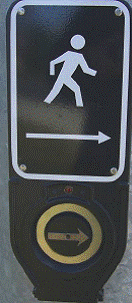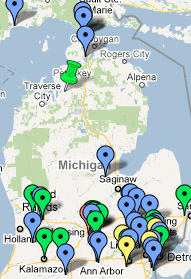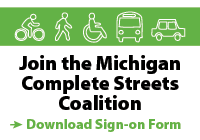You are currently browsing the tag archive for the ‘Pedestrians’ tag.
The Ann Arbor City Council unanimously approved a new pedestrian safety ordinance last July that gives walkers and bicyclists the upper hand when trying to brave traffic to cross city streets.
It’s a new kind of share-the-road philosophy, and city officials acknowledge it will take time and education to change the current culture. In the words of Police Chief Barnett Jones, it’s an effort to stop pedestrians from “playing Frogger trying to cross our roadways.”
The ordinance change, brought forward by Council Member Carsten Hohnke and Mayor John Hieftje, clarifies the obligation of motorists to yield to pedestrians in crosswalks.
According to the new ordinance, when traffic control signals aren’t in place or aren’t in operation, the driver of a vehicle must stop and yield the right-of-way to every pedestrian not only within a crosswalk, but also pedestrians approaching a crosswalk.
Taking a stroll? Ann Arbor is the safest city in Michigan to do it, while Flint is the most dangerous according to a national report released today.
Overall, the number pedestrians killed each year in Michigan is above the national average (12.2% in Michigan, compared with 11.8% nationally). Cities including Lansing, Grand Rapids and Jackson scored favorably, while Detroit, Monroe, and others scored well below the national average. Click here for the complete data on Michigan.
More than 4,500 Americans died last year while walking in the nation’s cities and towns. In Michigan, 253 pedestrian fatalities were recorded in 2007 and 2008.
The report—Dangerous by Design: Solving the Epidemic of Preventable Pedestrian Deaths—was authored by Transportation for America and the Surface Transportation Policy Partnership. It was released in Michigan through the Michigan Environmental Council.
The report shows that communities that invest in safe, complete streets — those that encourage pedestrians, cyclists and motorists to coexist safely — are the safest places to walk. Walk- friendly policies and infrastructure should be a key pillar of policies to encourage revitalization of urban cores throughout the state.
Unfortunately, only a trickle of transportation funding is used to address pedestrian safety. Pedestrian deaths account for 12 percent of all traffic deaths, yet only 1.5 percent of funds available in the current federal transportation bill are directed toward pedestrian safety.
PowerPoint dismisses liability concerns for constructing roadways that accommodate pedestrians and bicyclists
A must view PowerPoint for all Michigan road agencies, planners, engineers and politicians. Written by Ronald W. Emery (Transportation Division Dept. of Attorney General), Josh DeBruyn (Bicycle and Pedestrian Coordinator - MDOT) and Deirdre Thompson (Bicycle and Pedestrian Safety Engineer - MDOT), this PowerPoint demonstrates through case law that NO liability risk exists for accommodating nonmotorized facilities users through bike lanes, road diets, mid-block crossings or signing rural roads/shoulders as bike routes.
Download Presentation: Ped Bike Safety and Liability
Questions on this presentation can be directed to:
Josh DeBruyn, AICP
Bicycle and Pedestrian Coordinator
Bureau of Transportation Planning
Michigan Department of Transportation
517-335-2918

Push button integrated Accessible Pedestrian Signals (APS).
According to the June 25th edition of the U.S, Access Board’s Access Currents, “Product innovations and improved technologies have enhanced the accessibility of pedestrian signals now on the market. Low-volume audible signals and tactile features have been incorporated into the design of products to provide access to pedestrians with vision impairments more effectively. The industry standard, the Manual on Uniform Traffic Control Devices, includes specifications for accessible pedestrian signals which derive from recommendations developed by a former Board advisory panel, the Public Rights-of-Way Access Advisory Committee.
“The Board has released new guidance on installing these types of pedestrian signals. ‘Common Problems Arising in the Installation of Accessible Pedestrian Signals’ reviews access features of available products, including locator tones, audible and vibrotactile indicators of crossing cycles, and signal volume and explains important considerations in the placement and orientation of signal devices. The low-volume indicators of current products make proper installation essential in order for signals to be effective. The bulletin uses case studies and field evaluations to illustrate various installation ‘do’s and don’ts’ in relation to common site conditions and factors.”
The publication, which includes an installation checklist and other resources on accessible public rights-of-way are available on the Board’s website at:
http://tinyurl.com/ncogn4















